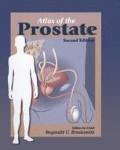Abstract
Although benign prostatic hyperplasia (BPH) is one of the most common disease processes affecting the aging man, surprisingly little is known about its pathophysiology [1]. Despite intense research efforts in the past four to five decades to find the underlying cause of prostatic growth in older men, cause and effect relationships have not been established. Previously held notions that the clinical symptoms of BPH (prostatism) are simply due to a mass-related increase in urethral resistance are too simplistic. It is now clear that a significant portion of the symptoms are caused by obstruction-induced detrusor dysfunction. Moreover, obstruction may induce a variety of neural alterations in the bladder and prostate that contribute to symptomatology. Undoubtedly, the constellation of cellular pathologies that give rise to the symptoms of BPH will be far more complex than we currently realize. Only by revealing these complexities, however, will we be able to successfully design alternative strategies to treat, and possibly prevent, BPH.
Access this chapter
Tax calculation will be finalised at checkout
Purchases are for personal use only
Preview
Unable to display preview. Download preview PDF.
References
McConnell JD: Epidemiology, etiology, pathophysiology and diagnosis of benign prostatic hyperplasia. In Campbell’s Urology, edn 7. Edited by Walsh PC, Retik AB, Vaughan ED, et al. Philadelphia: WB Saunders; 1998: 1429–1452.
McNeal J: Pathology of benign prostatic hyperplasia: insight into etiology. Urol Clin North Am 1990, 17: 477–486.
Barry MJ, Boyle P, Garraway M, et al.: Epidemiology and natural history of BPH. In Proceedings of the Second International Consultation on Benign Prostatic Hyperplasia (BPH). Channel Islands: Scientific Communications International; 1993:19.
Guess HA: Epidemiology and natural history of benign prostatic hyperplasia. Urol Clin North Am 1995, 22: 247–261.
Guess HA, Arrighi HM, Metter AJ, et al.: Cumulative prevalence of prostatism matches the autopsy prevalence of benign prostatic hyperplasia. Prostate 1990, 17:241–246.
Berry SJ, Coffey DS, Walsh PC, et al.: The development of human benign prostatic hyperplasia with age. J Urol 1984, 132: 474–479.
Girman CJ, Jacobsen SJ, Guess HA, et al.: Natural history of prostatism: relationship among symptoms, prostate volume and peak urinary flow. J Uro11995, 153:1510–1515.
Girman CJ, Panser LA, Chute CG, et al.: Natural history of prostatism: urinary flow rates in a population-based study. J Urol 1993, 150:887–892.
McConnell JD, Bruskewitz R, Walsh P, et al. for the PLESS Group: The effect of finasteride on the risk of acute urinary retention and the need for surgical treatment among men with benign prostatic hyperplasia. N Engl J Med 1998, 338: 557–563.
Levin RM, Monson FC, Haugaard N, et al.: Genetic and cellular characteristics of bladder outlet obstruction. Urol Clin North Am 1995, 22:263–283.
Gosling JA, Gilpin SA, Dixon JS, et al.: Decrease in the autonomic innervation of human detrusor muscle in outflow obstruction. J Urol 1986, 136:501–504.
Jacobsen SJ, Jacobsen DJ, Girman CJ, et al.: Natural history of prostatism: risk factors for acute urinary retention. J Urol 1997, 158: 481–487.
Barry MJ, Cockett ATK, Holtgrewe HL, et al.: Relationship of symptoms of prostatism to commonly used physiological and anatomical measures of the severity of benign prostatic hyperplasia. J Urol 1993, 150:351–358.
McConnell JD: Prostate growth: new insights into hormonal regulation. Br J Urol 1995, 76 (suppl 1): 5–10.
Russell DW, Wilson JD: Steroid 5a-reductase: two genes/two enzymes. Annu Rev Biochem 1994, 63: 25–61.
Silver RI, Wiley EL, Thigpen AE, et al.: Cell type specific expression of steroid 5-a-reductase 2. J Urol 1994, 152:438–442.
Silver RI, Wiley EL, Davis DL, etal.: Expression and regulation of steroid 5areductase 2 in prostate disease. J Urol 1994, 152: 433–437.
Walsh PC, Hutchins GM, Ewing LL: Tissue content of dihydrotestosterone in human prostatic hyperplasia is not supranormal. J Clin Invest 1983, 72: 1772–1777.
Shapiro E, Hartanto V, Lepor H: Quantifying the smooth muscle content of the prostate using double-immuno-enzymatic staining and color assisted image analysis. J Urol 1992, 147: 1167–1170.
Martikainen P, Kyprianou N, Isaacs JT: Effect of transforming growth factor-p on proliferation and death of rat prostatic cells. Endocrinology 1990, 127: 2963–2968.
Story MT, Livingstone B, Baeten L, etal.: Cultured human prostate-derived fibroblasts produce a factor that stimulated their growth with properties indistinguishable from basic fibroblast growth factor. Prostate 1989, 15: 355–365.
Lepor H, Tang R, Meretyk S, Shapiro E: Alpha1 adrenoceptor subtypes in the human prostate. J Urol 1993, 149: 640–642.
Lepor H, Tang R, Shapiro E: The alpha-adrenoceptor subtype mediating the tension of human prostatic smooth muscle. Prostate 1993, 22: 301–307.
Kobayashi S, Tang R, Wang B, et al.: Binding and functional properties of endothelin receptor subtypes in the human prostate. Mol Pharmacol 1994, 45: 306–311.
Steers WD, Ciambotti J, Erdman S, et al.: Morphological plasticity in efferent pathways to the urinary bladder of the rat following urethral obstruction. J Neurosci 1990, 19:1943.
Abernathy BB, McConnell JD, et al.: Smooth muscle myosin heavy chain isoform expression in bladder outlet obstruction. World J Urol 1996, 14:295–300.
Editor information
Editors and Affiliations
Rights and permissions
Copyright information
© 2003 Current Medicine, Inc.
About this chapter
Cite this chapter
McConnell, J.D. (2003). The Epidemiology and Pathophysiology of Benign Prostatic Hyperplasia. In: Bruskewitz, R.C. (eds) Atlas of the Prostate. Current Medicine Group, London. https://doi.org/10.1007/978-1-4615-6505-5_1
Download citation
DOI: https://doi.org/10.1007/978-1-4615-6505-5_1
Publisher Name: Current Medicine Group, London
Print ISBN: 978-1-4615-6507-9
Online ISBN: 978-1-4615-6505-5
eBook Packages: Springer Book Archive

